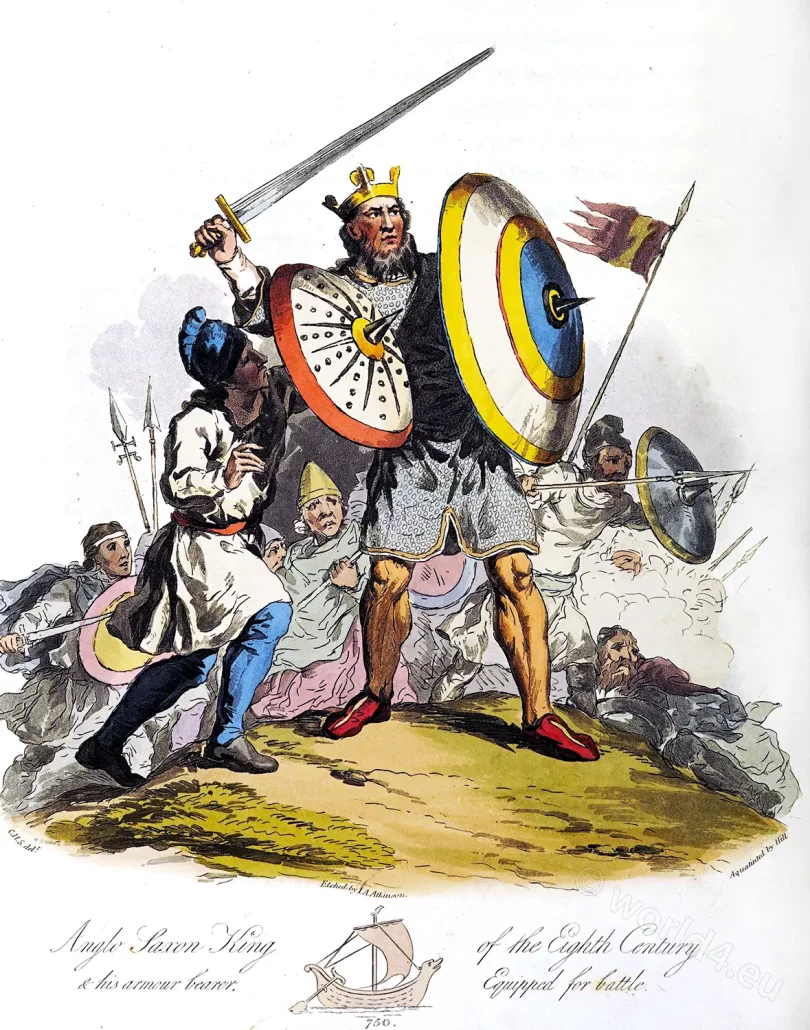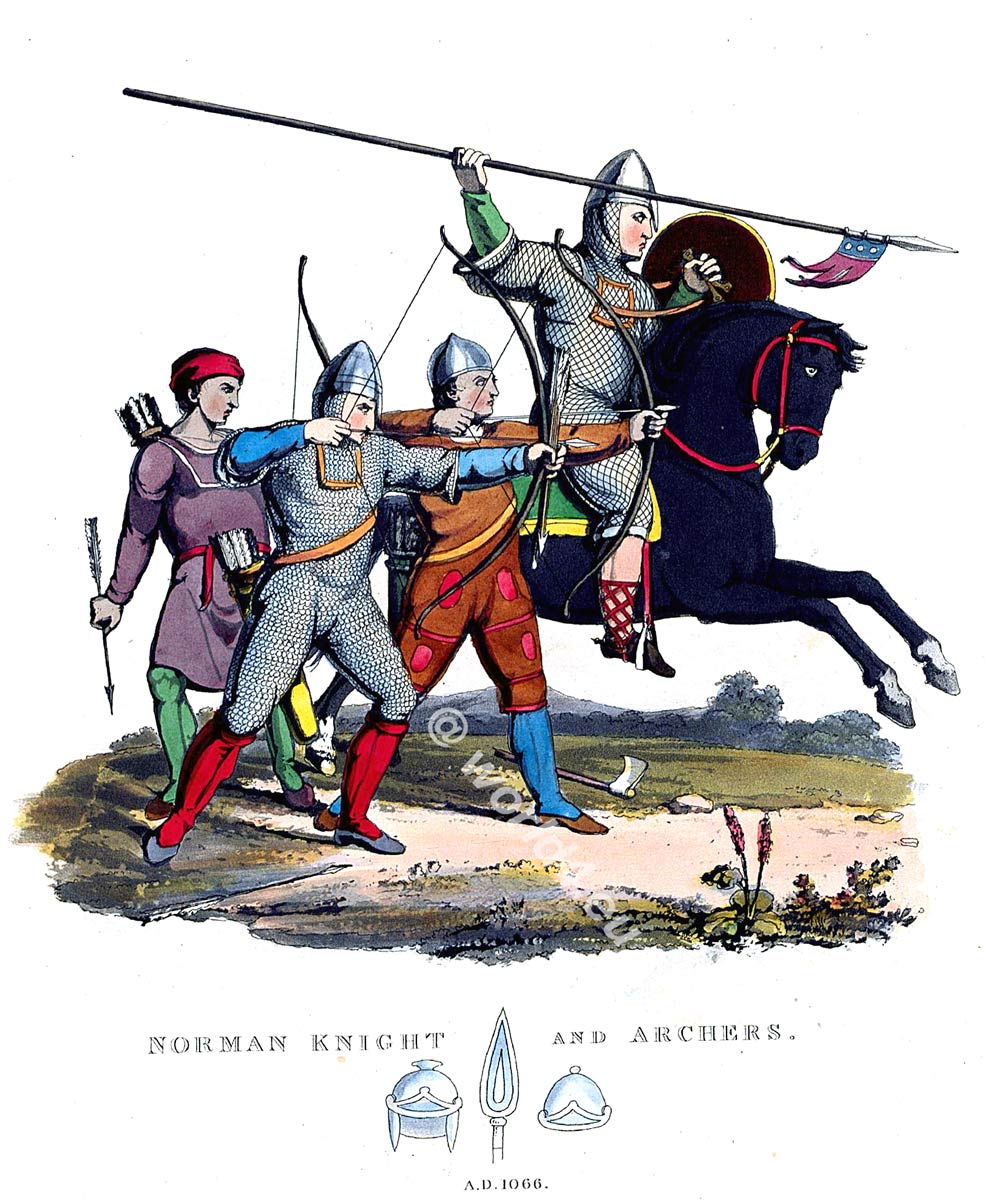COSTUME OF THE EIGHTH CENTURY.
ANGLO-SAXON KING AND HIS ARMOUR-BEARER EQUIPPED FOR BATTLE. ANNO 750
by Charles Hamilton Smith.
The Pagan Saxons, as described by Sidonius Apollinaris and Paulus Diaconus, were totally destitute of defensive armour, and almost of clothing; confiding in their lofty statures and hardened constitutions, they defied alike the injuries of the weather and the weapons of the enemy. A short tunic was deemed sufficient to resist the former, and a broad shield served to protect them against the latter: a heavy spear and a broad sword were the offensive arms upon which they chiefly depended.
The battle-axe was likewise in common use among them ; and it is asserted, that the national denomination of Saxons was derived from Se-ax, the name by which this weapon was distinguished. *) But after they had penetrated into the dismembered provinces of the Roman empire, and vanquished nations more civilised than themselves, their love of novelty and natural ingenuity, led them to adopt many habits and customs of those among whom they were settled, and whose religion they had recently begun to approve.
*) It is singular that the Saxons should have derived their name from this weapon, and the Franks from the Francia, which was another kind of battle-axe; and yet that modern authors should pretend that the axe and bipennis 1) were solely used by the Danes; probably battle-axes were generally used by all the barbarous tribes, until by commixture with more civilised nations, they gradually relinquished this rude weapon; and the Danes being the last of the northern invaders, were also the last to abandon it.
1) The labrys (of unknown, probably Aegean or Anatolian origin), also known as a double axe or, rarely, an Amazon axe, refers to an axe with two opposing rounded blades, which was used as a cult object or status symbol from around 2000 BC in the Early Bronze Age, but occasionally even earlier. The Persian double axe, for example, was used as a weapon.
Their houses, which hitherto had been circular hovels, assumed a square form; and their ships were likewise improved, by imitating the remains of Roman models. The use of trousers became common; the hood and mantle was introduced, and they even imitated the practice of painting their bodies.
Defensive armour became in vogue; their ancestors had fought hare headed, or protected by incommodious square helmets, which hung like boxes about their temples: they now assumed the conical cap; and in the specimen before us, we have the first instance that can be found in the designs of the Anglo-Saxons, still extant in this kingdom, of defensive armour. *)
*) There are some instances of this kind of helmets in my own collection of drawings, taken from early Anglo-Saxon MSS. Strutt has likewise published the figure of a king, with a quadrangular crown. See Dresses and Habits, Plate XVII. See also Montfaucon Mon. Francaise, Plate XXVI.—These square helmets are noticed by the ancient Welsh bards.
The original is meant to depict Abraham, attended by his armour bearer, engaged against the five kings to rescue his brother Lot.
The person of the patriarch or chief, is the only one protected by body armour; and the design tends to prove, that in the eighth century, princes alone, among the Saxons, were provided with such an improved safeguard for their bodies. Judging of the rude design from which the drawing is taken, it would appear, that the lorica or cuirass, consists of some strong substance, probably leather, upon which iron rings have been sowed closely together. His head is encircled with a crown, consisting of a band, surmounted by three fleur de lys,
This, Mr. Strutt considers as the cinin-helme, or king’s crown of Verstegan; but it is probable, that the crown and helmet of a chief was not the same; but that the latter partook of something of the shape of those which are visible on the seals of King Edward the Confessor; that is, a coronet imposed upon a skull cap of leather or metal.
In the crowd behind the king is seen a banner, such as are often designed in Saxon illuminations : none, however, are distinguished by armorial bearings, although it is asserted that the first invaders bore the resemblance of a horse in their standards. Sigmund Birken, and other modern Saxon genealogists and heralds affirm, that the two chieftains who first landed in Britain, as well as all their Pagan descendants, bore a black horse (the coal black steed of Odin), and that the white horse was assumed after their conversion to Christianity.
But whether Hengest and Horsa assumed the representation of this animal in reverence to the steed of Odin, or as the type of their own names; *) or whether it was borrowed from the Britons, is not easy to determine : certain it is, that the figure of a horse, or more properly a mare, was stamped upon British coins as early as the reign of Cunobelin; not indeed as an armorial distinction, but as connected with some mystical reference to the archite worship of the Druids.
*) Hengst, a stallion. Horsa, Hros,—a horse.
In the back-ground are several other Anglo-Saxon warriors engaged in action; below, an ancient specimen of a ship.
AUTHORITIES.
The king and armour-bearer from a MS. in the Cotton library at the British Museum, marked Claudius, B. IV. The ship from a drawing, which I consider as the most ancient delineation now remaining: it is copied from an Anglo-Saxon celestial sphere, in a curious MS. in the Harleian Collection B. M. marked 647. The design represents the constellation Argo, and must necessarily have been a copy of one still more ancient.
Source: Selections of the ancient costume of Great Britain and Ireland from the seventh to the sixteenth century, by Charles Hamilton Smith. London: Colnaghi, 1814.
Discover more from World4 Costume Culture History
Subscribe to get the latest posts sent to your email.








